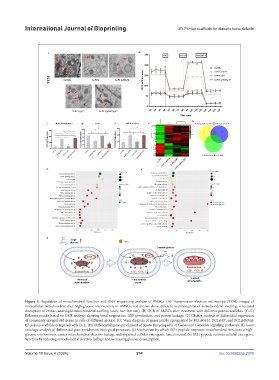Page 222 - IJB-10-4
P. 222
International Journal of Bioprinting 3D-Printed scaffolds for diabetic bone defects
Figure 5. Regulation of mitochondrial function and RNA sequencing analysis of BMSCs. (A) Transmission electron microscopy (TEM) images of
intracellular mitochondria after high-glucose intervention in BMSCs; red arrows show different manifestations of mitochondrial swelling, structural
disruption of cristae, and slight mitochondrial swelling (scale bar: 100 nm). (B) OCR of BMSCs after treatment with different porous scaffolds. (C–E)
Relevant results based on OCR analysis showing basal respiration, ATP production, and proton leakage. (F) Cluster analysis of differential expression
of commonly upregulated genes in cells of different groups. (G) Venn diagram of genes jointly upregulated by PCL@SS31, PCL@E7, and PCL@SS31@
E7 porous scaffolds compared with PCL. (H) Differential gene enrichment of Kyoto Encyclopedia of Genes and Genomes signaling pathways. (I) Gene
ontology analysis of differential gene enrichment biological processes. (J) Mechanism by which SS31 peptide improves mitochondrial function: a high-
glucose environment causes mitochondrial electron leakage and impaired cellular osteogenic function, and the SS31 peptide restores cellular osteogenic
function by reducing mitochondrial electron leakage and increasing glucose consumption.
Volume 10 Issue 4 (2024) 214 doi: 10.36922/ijb.2379

